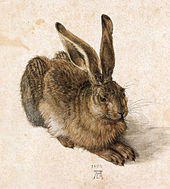Animal painting
The animal painting is next to the landscape , the history image , the portrait , the genre picture and the still life , a genus of the subject painting.
story

In the 16th century the "animal piece" developed into an area of still life ; The brown hare , a watercolor by Albrecht Dürer, has been passed down as one of the best-known examples . The Dutchman Roelant Savery , Frans Snyders and Paul Potter staffierten in the 17th century landscapes from animal groups.
In the age of the Enlightenment , the interest in the morphological peculiarities of nature, especially the fauna , increased; the artists sought to see the living object. The French court painter Jean-Baptiste Oudry made drawings and color studies in the menagerie of King Louis XV. in Versailles in order to be able to represent the animals in life size in the studio. George Stubbs became one of the most famous horse portraitists of the 18th century in England.
In the 19th century, animal painting became popular in genre painting ; The decisive factor was the increased demand from a wide audience for animal representations due to natural history education.
Depiction of animals "after life"
The establishment of zoological gardens and the performances of traveling animal shows increasingly aroused people's interest in animals and their habits. The depiction of animals became a lucrative profession for the painters, who also met the increased need for naturalistic drawings in order to equip the journals and magazines, but also the natural history textbooks with animal illustrations from life . The familiar animals of the area and the domestic animals also became a selling point for the artists.
Edwin Landseer , whose lifelike paintings of animals alluded to human social customs in the title, was the most famous animal painter in England at the time of Queen Victoria and ennobled for his art. Rosa Bonheur was both artistically and economically very successful with realistic animal depictions. Paul Friedrich Meyerheim depicted scenes from traveling animal shows in numerous paintings, which were also sold as photo engravings . Heinrich Leutemann devoted himself to the representation of Carl Hagenbeck's animal and people show and worked as an animal illustrator for the gazebo and the Munich picture sheets . Anton Braiths preferred subjects were sheep and cows, which he occasionally put into the painted picture as momentary images corresponding to photography .
With the use of photographic reproduction techniques at the end of the 19th century, photography took over the task of painted and drawn depictions of animals from life in the course of the 20th century .
Modern animal representation
While in the past the depictions of animals were often used as a substitute for the missing or insufficiently developed photography, in the present the depictions of animals are also seen in terms of dynamism or design. With this form of representation, the focus is not on the realistic depiction of body and shape, but on the play of colors combined with fragments of movement. Artists often try to convey feelings through this.
literature
- Keyword animal representations in: Lexicon of Art . Vol. 5. Berlin, 1981; P. 138ff.
- John Berger : Why do we look at animals? . In: ders .: The life of pictures or the art of seeing . Berlin 1989, ISBN 3-8031-1114-5 , pp. 12-35.
- Claudia List: Animals - Shape and Meaning in Art . Belser, Stuttgart, Zurich, 1993, ISBN 3-7630-2301-1 .
- Siegfried Nöhring: "The animal in art" from the 18th to the 21st century (from Adam to Unger), edited by Beate von Kessel, Verlag Galerie für representliche Kunst Kirchheim-Teck and Rietzschel & Russ (Munich), 2001. ISBN 3-935172-05-2 .
- Bernd Küster, Mamoun Fansa, Edwald Gäßler: TierARTen - the animal in art and cultural history . Exhibition catalog, group exhibition Oldenburg Museums, 2006, ISBN 3-938275-16-2 .
- Christiane Luz: Exotic worlds, European fantasies - the exotic animal in European art . Exhibition catalog, Edition Cantz, Stuttgart, 1987, ISBN 3-922608-71-X .
- Erika Rödiger Diruf (head): Challenge animals - from Beuys to Kabakov . Exhibition catalog, Städtische Galerie Karlsruhe, Prestel, Munich, London, New York, 2000, ISBN 3-7913-2275-3 .
- Zvjezdana Cimerman, Daniel Ammann: The animal in contemporary art Tierschutzverlag, Zurich, 2002, ISBN 3-908157-04-8 .
- Tamsin Pickeral: The horse - 30,000 years of horses in art . DuMont, Cologne, 2007, ISBN 978-3-8321-7794-2 .
- Helmut Meyer, Gudrun Meyer: Horses bridled differently - forays into natural and art history . Schlütersche, Hannover, 2002, ISBN 3-87706-695-X .
- Annett Reckert: The horse in contemporary art . Exhibition catalog, Kunsthalle Göppingen, Hatje Cantz, 2002, ISBN 978-3-7757-1836-3 .
- Michael Brackmann: Cow Art Guide . Landwirtschaftsverlag, Münster, 2006, ISBN 3-7843-3389-3 .
- Thomas Macho: Poor pigs - a cultural story . Nicolai'sche Verlagsbuchhandlung, Berlin, 2006, ISBN 3-89479-343-0 .
- Siegfried Scholtyssek: The chicken in art . Offizin Chr.Sheufele, Stuttgart, 2002, ISBN 3-8001-4224-4 .
- Daniel Haag-Wackernagel : The pigeon - from the sacred bird of the goddess of love to the street pigeon. Schwabe, Basel 1998, ISBN 3-7965-1016-7 .
- Erika Billeter: Dogs and their painters - between Titian's aristocrats and Picasso's jugglers . Benteli, Bern, 2005, ISBN 978-3-7165-1348-4 .
- Erika Rödiger-Diruf u. a. (Red.): The cat in art . Kehrer, Heidelberg, 2007, ISBN 3-939583-10-3 .




